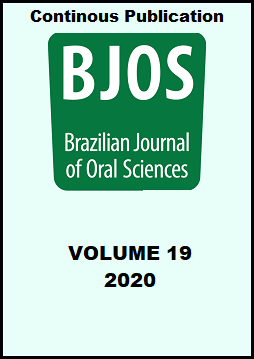Abstract
Aim: To evaluate the aesthetic self-perception capacity of adolescents from public schools regarding the presence of oral alterations from malocclusions. Methods: Cross-sectional and quantitative study with 374 adolescents between 16 and 18 years old, belonging to public schools in the city of Parnaíba, Piauí. The adolescents were separated by gender (male and female) and examined for malocclusions. The problem identified for each participant was recorded for later comparison of the influence of its presence with aesthetic self-perception. Then, all adolescents, including those who demonstrated normal occlusion during the clinical evaluation, answered a questionnaire containing eight questions about their perception of their own smile and its impact on their interpersonal relationships. Self-perception was also analyzed by comparing the responses of those with normal occlusion with that of malocclusion individuals. Student's t-tests were used to verify if there was a difference between the groups. Results: The most prevalent malocclusions after clinical examination were midline deviations, crowding and diastemas, and the ones that most scored in the adolescents' perception were crowding, misalignment and diastemas. Conclusion: The adolescents were able to perceive the aesthetic alterations resulting from malocclusions, being determinants of dissatisfaction when smiling. They were not ashamed to smile, did not consider that the ideal smile would improve their self-esteem and that misaligned teeth would not interfere with flirting and interpersonal relationships.
References
Mail LR, Donassollo SH, Donassolo TA. Malocclusion Diagnosis: Normative Criteria and Self-Perception of Adolescents. Braz Res Pediat Dent Integr Clin. 2015;15(1):197-203. doi:10.4034/PBOCI.2015.151.21.
Eslamipour F, Afshari Z, Najimi A. Prevalence of malocclusion in permanent dentition of Iranian population: a review article. Iran J Public Health 2018 Feb;47(2):178-87.
Silveira MF, Freire RS, Nepomuceno MO, Martins AMEBL, Marcopito LF. Severity of malocclusion in adolescentes: population-based study in the north of Minas Gerais, Brazil. Rev Saude Publica. 2016;50(11):1-11. doi:10.1590/S1518-8787.2016050005861.
Brizon VSC, Cortellazzi KL, Vasquez FL, Ambrosano GMB, Pereira AC, Gomes VE, et al. [Individual and contextual factors associated with malocclusion in Brazilian children]. Rev Saude Publica. 2013 Dec;47 Suppl 3:118-28. doi: 10.1590s0034-8910.2013047004426. Portuguese.
Almeida AB, Leite ICG, Melgaço CA, Marques LS. Dissatisfaction with dentofacial appearance and the normative need for orthodontic treatment: determinant factors. Dental Press J Orthod. 2014 May-Jun;19(3):120-6. doi:10.1590/2176-9451.19.3.120-126.oar.
Gatto RCJ, Garbin AJI, Corrente JE, Garbin CAS. Self-esteem level of Brazilian teenagers victims of bullying and its relation with the need of orthodontic treatment. RGO. 2017 Jan-Mar;65(1):30-6. doi: 10.15901981-863720170001000053304.
Costa AC, Rodrigues FS, Heimer MV. [Self concept of dental aesthetics and its impact on the life of adolescents]. Adolesc Saude. 2017 Oct-Dec;14(4):157-66. Portuguese.
Sharma A, Mathura A, Batra M, Makkara DK, Aggarwala VP, Goyal N, et al. Objective and subjective evaluation of adolescent’s orthodontic treatment needs and their impact on self-steem. Rev Paul Pediatr. 2017 Jan-Mar;35(1):86-91. doi: 10.1590/1984-0462/;2017;35;1;00003.
Soto KLZP, Ely HC, Mallmann FH, Abegg C. [Need for orthodontic treatment in adolescents from the state of Rio Grande do Sul, Brazil: association between self-perception and clinical need]. RFO. 2018 May-Aug;23(2):186-92. doi: 10.5335rfo.v23i2.8345. Portuguese.
Freitas CV, Souza JGS, Mendes DC, Pordeus IA, Jones KM, Martins AMEBL. Need for orthodontic treatment in Brazilian adolescents: health-based assessment public. Rev Paul Pediatr. 2015 Apr/Jun;33(2):204-10. doi: 10.1016j.rpped.2014.04.006.
Abualella M, Abuaffan AH. Psychosocial impact of dental aesthetics among sudanese high school students. Braz Dent Sc. 2016 Abr-Jun;19(2):32-9. doi: 10.14295/bds.2016.v19i2.1225.
Luchesa CJ. Chaves Neto A. [Calculation of sample size in administration research]. Curitiba: Edição do autor; 2011 [cited 2019 Aug 12]. 27p. Available from: https://www.unicuritiba.edu.br/images/calculo_do_tamanho_da_amostra_-_texto_final_para_impressapso1.pdf. Portuguese.
Peres MA, Traebert J, Marcenes W. [Calibration of examiners for dental caries epidemiology studies]. Cad Saude Publica. 2001 Jan-Feb;17(1):153-9. Portuguese.
Brook PH, Shaw WC. The development of an index of orthodontic treatment priority. Eur J Orthod. 1989 Aug;11(3):309¬-20. doi:10.1093/oxfordjournals.ejo.a035999
Martins LP, Bittencourt JM, Bendo CB, Vale MP, Paiva SM. Malocclusion and social vulnerability: a representative study with adolescents from Belo Horizonte, Brazil. Cien Saude Colet. 2019 Feb;24(2):393-400. doi: 10.1590/1413-81232018242.33082016.
Marques LS, Barbosa CC, Ramos-Jorge ML, Pordeus IA, Paiva SM. Malocclusion prevalence and orthodontic treatment need in 10-14-years-old schoolchildren in Belo Horizonte, Minas Gerais State, Brazil: a psychosocial focus. Cad Saude Publica. 2005 Jul-Aug;21(4):1099-106. doi: 10.1590/S0102-311X2005000400012. Portuguese.
Nunes Neto TA, Thomaz EBAF, Ferreira MC, Santos AM, Queiroz RCS. [Dental spacing problems and associated factors among Brazilian adolescents]. Cien Saude Colet. 2014 Nov;19(11):4555-68. doi: 10.15901413-812320141911.15932013. Portuguese.
Danaei SM, Salehi P. Association between normative and self-perceived orthodontic treatment need among 12- to 15-year-old students in Shiraz, Iran. Eur J Orthod. 2010 Oct;32(5):530-4. doi: 10.1093/ejo/cjp139.
Choi SH, Kim JS, Cha JY, Hwang CJ. Effect of malocclusion severity on oral health – related quality of life and food intake ability in a Korean population. Am J Orthod Dentofacial Orthop 2016 Mar;149(3):384-90. doi: 10.1016/j.ajodo.2015.08.019.
Rodrigues FS, Costa AC, Heimer MV. [Impact of malocclusions in the quality of life of adolescents]. Adolesc Saude. 2016 Aug/Sep;13(1):110-7. Portuguese.
Lira ALS, Sousa FDC. Evaluation of the influence of malocclusion in interpersonal relations among adolescentes. Braz Dent Sci. 2020 Jan-Mar;23(1):1-9. doi: 10.14295/bds.2020.v23i1.1799.
Sotto KLZP, Hely HC, Mallmann FH, Abegg C. [Need for orthodontic treatment in adolescents from the state of Rio Grande do Sul, Brazil: association between self-perception and clinical need]. RFO. 2018 May-Aug;23(2):86-92. doi:10.5335/rfo.v23i2.8345. Portuguese.
The Brazilian Journal of Oral Sciences uses the Creative Commons license (CC), thus preserving the integrity of the articles in an open access environment.


